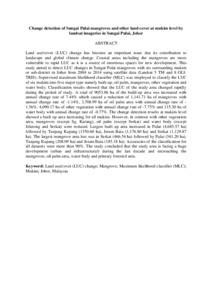Citation
Sarmin, Noor Shaila and Ismail, Mohd Hasmadi and Hassan Zaki, Pakhriazad and Awang, Khairil Wahidin
(2017)
Change detection of Sungai Pulai mangroves and other land cover at mukim level by landsat imageries in Sungai Pulai, Johor.
The Malaysian Forester, 80 (1).
31 - 42.
ISSN 0302-2935
Abstract
Land use/cover (LUC) change has become an important issue due its contribution to landscape and global climate change. Coastal areas including the mangroves are more vulnerable to rapid LUC as it is a source of enormous spaces for new development. This study aimed to detect LUC changes in Sungai Pulai mangroves with six surrounding mukim or sub-district in Johor from 2004 to 2014 using satellite data (Landsat 5 TM and 8 OLI-TRIS). Supervised maximum likelihood classifier (MLC) was employed to classify the LUC of six mukim into five major type namely built-up, oil palm, mangroves, other vegetation and water body. Classification results showed that the LUC of the study area changed rapidly during the period of study. A total of 9053.86 ha of the build-up area was increased with annual change rate of 7.44% which caused a reduction of 1,141.71 ha of mangroves with annual change rate of -1.14%, 3,708.99 ha of oil palm area with annual change rate of -1.56%, 4,090.17 ha of other vegetation with annual change rate of -7.75% and 115.30 ha of water body with annual change rate of -0.77%. The change detection results at mukim level showed a built up area increasing for all mukim. However, in contrast with other vegetation area, mangroves (except Sg. Karang), oil palm (except Serkat) and water body (except Jelutong and Serkat) were reduced. Largest built up area increased in Pulai (4,685.57 ha) followed by Tanjung Kupang (1550.60 ha), Jeram Batu (1,176.80 ha) and Serkat (1,129.87 ha). The largest mangrove area lost was in Serkat (466.54 ha) followed by Pulai (341.20 ha), Tanjung Kupang (208.09 ha) and Jeram Batu (185.18 ha). Accuracies of the classification for all datasets were more than 90%. The study concluded that the study area is facing a huge development (urban and infrastructural) during the last decade and encroaching the mangroves, oil palm area, water body and primary forested area.
Download File
![[img]](http://psasir.upm.edu.my/61072/1.hassmallThumbnailVersion/Change%20detection%20of%20Sungai%20Pulai%20mangroves%20and%20other%20land%20cover%20at%20mukim%20level%20by%20landsat%20imageries%20in%20Sungai%20Pulai%2C%20Johor.pdf)  Preview |
|
Text (Abstract)
Change detection of Sungai Pulai mangroves and other land cover at mukim level by landsat imageries in Sungai Pulai, Johor.pdf
Download (6kB)
| Preview
|
|
Additional Metadata
Actions (login required)
 |
View Item |

